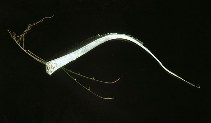| FishBase |
Larvae Information Summary for
Regalecus glesne

| Main Ref: | Bauchot, M.-L. 1995 | |||
Yolk-sac larvae
| max | min | mod | Ref. | |
| Length at birth (mm) | 8 | 6 | ||
| Preanal L. % TL |
| Place of development | planktonic | |||
| Larval area | Eastern Central Pacific | |||
| Yolk-sac | Ref: | |||
| Yolk | Oil globules | |||
| Melanophores on head + trunk | melanophores on trunk | |||
| Newly hatched larvae have one elongate or filamentous, ornamented and flexible ray in the dorsal fin and in each of the single-rayed pelvic fins. Dorsal fin has 2-3 very short rays without ornaments followed by a hundred or so long slender rays gradually diminishing in size posteriorly. The ornaments consist of large darkened swellings or flaps with granule-like dark pigmentation. The rest of the dorsal fin and the caudal fin are not developed at hatching; pectoral fins are developed but are rayless. The body has saddle-shaped areas of dark pigmentation along the dorsal and ventral margins of the myotomes, and is surrounded by a transparent thin membrane extending from behins the dorsal fin to arouns the end of the body and then forward to the vent (Ref. 92949). | ||||
Post larvae
| Striking feature | ||||
| Striking shape lateral | dorsal | |||
| Striking feature | ||||
| Shape of gut | ||||
| Gas bladder early | late | |||
| Spinal armature early | late | |||
| Early free-living larvae and small juveniles with a single dorsal fin crest usually composed of 5-6 rays. Larvae are miniature versions of adults, with highly elongate bodies and dorsal fins, and pelvic fins each consisting of a single ray. Myomeres well-developed, 45 to 60. (Ref. 92949). | ||||
Meristic characters
| max | min | mod | Ref. | |
| Total number of myomeres | 60 | 45 | 92949 |
| L 1st feeding | Ref. | Months of presence of larvae | ||||
| max | Jan | Feb | Mar | Apr | ||
| min | May | Jun | Jul | Aug | ||
| mod | Sep | Oct | Nov | Dec | ||
| Similar species 1 | 25038Regalecusrussellii |
| Remarks | |
| Water parameters Metric characters |
| Back to Search |